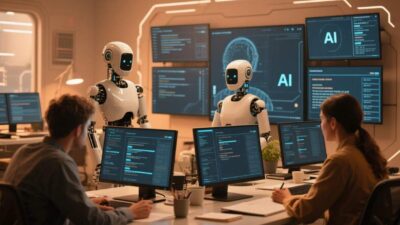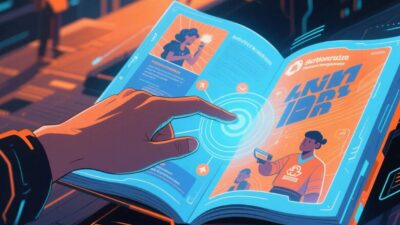Bridging Data and Emotion in the Art World
The Art of Curation in the Digital Age
Art galleries are more than spaces—they are portals to culture, history, and human expression. For centuries, human curators have acted as gatekeepers, selecting works that tell stories, challenge norms, and spark dialogue. But today, a new player has entered the arena: algorithmic curation. Powered by AI, machine learning, and data analytics, these systems promise to revolutionize how art is organized, displayed, and experienced. This report explores the battle (and collaboration) between algorithmic and human curators, examining their strengths, flaws, and the future of curation in art.
Algorithmic Curation: Data-Driven Art Selection
Algorithmic curation leverages AI to analyze vast datasets—artwork metadata, visitor behavior, historical trends, and even social media sentiment—to curate exhibitions. Tools like recommendation engines, clustering algorithms, and natural language processing (NLP) enable systems to “learn” from patterns and make data-driven choices.
Strengths of Algorithmic Curation
- Speed and Scalability: AI can process millions of artworks in minutes, identifying trends (e.g., rising interest in digital art) or underrepresented artists (e.g., women of color in surrealism) that human curators might miss. For example, Google Arts & Culture uses AI to recommend artworks based on user preferences, making collections accessible to global audiences.
- Personalization: Machine learning adapts to individual visitors. A family-friendly exhibit might highlight interactive installations, while a scholar’s tour could focus on rare manuscripts—all powered by data on past engagement.
- Efficiency: Galleries with massive collections (e.g., the Louvre’s 500,000+ artworks) use AI to streamline curation, reducing the time and cost of manual selection.
Limitations of Algorithmic Curation
- Bias in Data: AI systems inherit biases from their training data. For instance, an algorithm trained on Western art history might undervalue non-Western traditions, leading to underrepresentation.
- Lack of Nuance: Data struggles to capture emotional or contextual depth. A painting’s significance might hinge on its historical moment (e.g., a Civil Rights-era work) or the artist’s personal story—elements AI often overlooks.
- Emotional Disconnect: Algorithmic curation prioritizes “popularity” or “trends,” risking the exclusion of provocative or experimental art that challenges viewers.
Human Curators: The Human Touch in Art Storytelling
Human curators bring decades of expertise, intuition, and cultural awareness to their work. They curate not just art, but narratives—connecting pieces to broader themes (e.g., “identity,” “resilience”) and fostering emotional resonance.
Strengths of Human Curation
- Contextual Depth: Curators understand the “why” behind art. A 19th-century portrait might be paired with letters from the artist’s lover to illuminate its emotional core—a nuance AI often misses.
- Audience Engagement: Human curators craft experiences that resonate personally. A children’s tour might include tactile stations (e.g., feeling the texture of Van Gogh’s brushstrokes), while a late-night exhibit could pair art with live poetry to spark reflection.
- Cultural Sensitivity: Curators navigate complex histories, ensuring marginalized voices are centered. For example, the Smithsonian’s National Museum of African American History & Culture uses human curation to highlight underrepresented stories, avoiding algorithmic oversights.
Challenges in Human Curation
- Subjectivity: Curators’ personal biases (e.g., favoring abstract over figurative art) can skew selections, limiting diversity.
- Scalability: Curating a large collection (e.g., a museum with 100,000+ pieces) is time-intensive, leaving little room for experimentation.
- Resource Intensity: Training expert curators requires years of education and mentorship, a barrier for smaller galleries.
The Hybrid Future: Collaborating with AI to Elevate Curation
Rather than competing, algorithmic and human curators are increasingly working in tandem, blending data-driven efficiency with human intuition.
AI as a Tool, Not a Replacement
Galleries are using AI to augment human curation:
- Pre-Curation Support: AI filters options (e.g., “top 100 surrealist paintings”) so curators can focus on storytelling. The Tate Modern uses AI to shortlist works for exhibitions, allowing curators to refine the final selection.
- Visitor Insights: AI analyzes foot traffic and engagement data to suggest exhibit layouts (e.g., placing a controversial work in a high-traffic area to spark dialogue).
- Accessibility: AI-powered translation tools or audio guides (e.g., the Met’s “Art + Tech” app) make collections more inclusive, complementing human-led tours.
Case Studies: Galleries Blending Both Approaches
- The Barbican Centre (London): Partnered with AI startup Artfinder to recommend local artists for community exhibits, then had human curators refine the list to ensure cultural relevance.
- The National Gallery of Victoria (Australia): Used AI to identify underrepresented Indigenous artists, then collaborated with Aboriginal elders to contextualize their work in human-led tours.
A Balanced Future for Art Curation
Algorithmic curation and human curators are not adversaries—they are complements. AI excels at speed, scalability, and personalization, while humans bring depth, empathy, and cultural awareness. As galleries embrace hybrid models, the future of curation lies in collaboration: using data to inform choices, but letting human judgment shape the soul of the exhibit.
In the end, art is about connection—between the piece, the viewer, and the story it tells. Whether guided by algorithms or human hands, the goal remains the same: to make art accessible, meaningful, and unforgettable.



